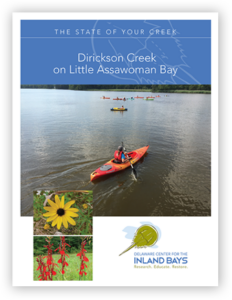Dirickson Creek
Dirickson Creek flows into Little Assawoman Bay at its southern end, just north of the state line near Fenwick Island. The watershed as a whole covers approximately 20 square miles and collects its waters primarily from agricultural ditches that drain the farmland to the west, and from groundwater that seeps into it.
The land in the southern part of the Little Assawoman Bay Watershed, which includes Dirickson Creek, was once part of the Great Cypress Swamp that extended from the middle of the state to the Atlantic. As the land was settled in the 19th and early 20th centuries, agricultural ditches were dug to drain the land for farming, changing the look of the landscape and altering the flow of water into the creek.
As agricultural land has given way to development around Dirickson Creek, the change in land use has given rise to new challenges, as outlined in the 2017 State of Dirickson Creek Report.


